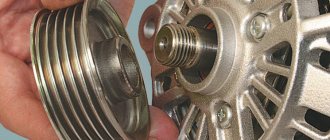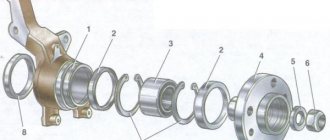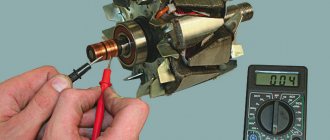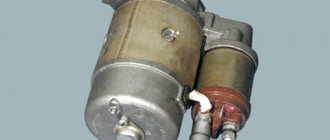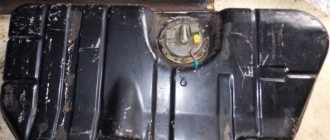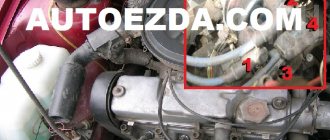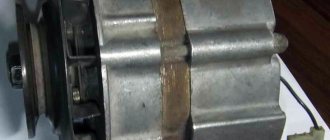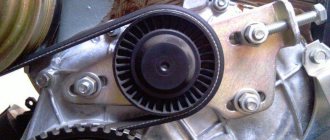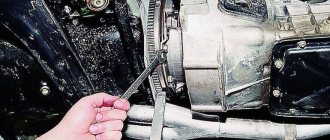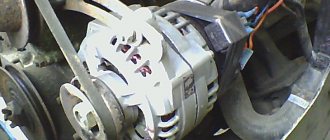Replacing a bearing in a generator
Replacing the VAZ 2109 generator bearing is simply necessary, since otherwise the generator will fail. And this will lead to the fact that it will be impossible to use the machine, since it does not work without a generator, and that, in turn, does not function without a bearing. If any defects are noticeable in the operation of the generator bearing, it must be replaced. Replacing the bearing on a VAZ 2109 generator can be done on your own.
How to fix a generator failure on a VAZ 2109?
There are various reasons for generator failure. But they all boil down to the fact that the product needs to be repaired or replaced. After all, driving a car is impossible without a generator.
Replacing and even repairing it is quite expensive.
You can, of course, contact a service station. But you have to pay a lot for this.
I suggest you fix the problem yourself.
To do this, please read this article carefully.
ABOUT REPLACING THE GENERATOR SET ON A CAR
It so happened that replacing the VAZ generator is necessary. The necessary spare part has been purchased. By the way, some car enthusiasts replace serviceable components with more powerful units. The reasons for this can be very different. Basically, this is the installation of new, additional electricity consumers. Powerful audio systems, good headlights, illumination of body kits and other similar “things” require an increase in the power of the generator set.
In such cases, a generator from Priora or Kalina is usually purchased and installed. Its generated current is approximately 115 A, while the standard device produces 80 A. Its mounting is similar to the standard one, only the drive belt pulley needs to be replaced. The matter is not very difficult; even inexperienced drivers can cope with it.
Required tools for replacing generators:
- Wrenches for “10”, “13”;
- Open-end wrench 17x19;
- Screwdriver Set;
- Mount.
Replacement work begins only after the battery is disconnected.
If the work is carried out in a garage with an inspection hole, then the following procedure can be recommended:
- Disconnect the engine protection. You can release it only in the area of the generator set and leave it hanging;
- Using a “10” wrench, tighten the nut on the protruding contact bolt of the generator and remove the wires from it. Also disconnect the connector from the brush assembly;
- Unscrew the tensioner bolt, the bolt securing it to the cylinder block and remove it from the engine;
- Now the nut of the bracket axle is unscrewed to mount the generator. This action is performed with a key set to “19”, remove the nut with the spacer washer and knock the axle out of the bracket.
The generator can be removed from the engine compartment and a new one installed in its place. Installation is carried out in reverse order. Connect the previously disconnected wires and connectors, and replace the drive belt. After this, you can try it out at work. Before starting the engine for testing, a few words about how to properly tension the alternator belt. This process is slightly different for different engine displacements. With a volume of 1.5 liters, the belt is tensioned by moving the generator housing away from the engine block with a pry bar. With a volume of 1.6 liters, tighten the belt using the tensioner screw.
Modern cars are equipped with a large amount of electrical equipment, both basic and additional. The source of current for its normal functioning is the battery. The battery is recharged when the engine is running by a generator set (also known as a generator).
Replacement
To replace it, you will need to remove the generator from the car and some plumbing tools. It would also be a good idea to have a generator bearing puller. Having all the necessary tools, you can handle the job with basic mechanical knowledge.
Puller
The puller greatly facilitates bearing replacement work, saving time, effort and nerves. This device is a faithful assistant not only when working with a generator, but also with other car parts.
It consists of claws and a thrust bolt. There are a large number of different pullers, they are: two-jaw and three-jaw. In our case, when working with a VAZ 2110 generator, it is best to use a two-jaw one; it is the most compact and convenient to dismantle the bearing.
Its cost varies from 200 to 1000 rubles, depending on the quality of the part.
Necessary tool
The tools you will need to complete the work are presented below:
Stages of work
1. Disconnect the negative terminal from the battery. We unscrew the wires on the generator with a 10mm wrench and remove the generator excitation chip.
2. We remove the generator from the car. To do this, unscrew the generator belt tension bolt and remove the belt, unscrew the generator from the mounts and remove it from the car. Be careful not to lose the rubber bushing and washers when removing the lower mounting bolt.
3. Let's start disassembling. Remove the plastic cover of the diode bridge by bending the three latches. Unscrew the two screws securing the brushes to the body and disconnect the connector from the brushes. We mark the alignment of the covers with a marker so that in the future we can assemble everything correctly.
4. Using a screwdriver, unscrew the screws of the ends of the generator winding from the diode bridge and bend them. Unscrew the screw securing the capacitor and separate the diode bridge from the generator.
5. We unscrew the generator pulley with a 21 mm socket, holding it with a gas wrench and holding the rotor shaft with an 8 mm hexagon. We take out the generator pulley and thrust washer.
6. Unscrew the 4 bolts of the cover and remove it along with the stator winding.
7. We take out the back cover by pressing the manifold with our fingers and pull the cover towards ourselves, remove the plastic bearing bushing.
8. Remove the bearings using a puller.
We assemble the generator in the reverse order.
We are sorting out the VAZ 2107 37.3701 generator
So in this article I will describe the generator overhaul. We will talk about the 37.3701 generator, although everything on the G-222 generator is almost identical and this article will be suitable for it with some adjustments. I bought for replacement: 1. Diode bridge - 190 rubles 2. Generator capacitor - 15 rubles 3. Bearings - I took Andycar - 65 rubles 4. four nuts for 8. The relay regulator on the generator is new, so I decided not to change it. We will also need a universal puller (I personally used a rod puller instead, it wasn’t very convenient, but after fiddling around I removed the bearing with it). It is very desirable to have a brush for metal; I bought a set of three brushes and some sandpaper.
Reasons leading to generator failure
First, you need to find out what the cause of the breakdown is.
They may be the following:
— short circuit of the stator winding turns;
— if used incorrectly, the voltage regulator is damaged;
— the current collection brushes are worn out;
- the pulley has become unusable;
— the generator bearing has collapsed;
— rectifier failure;
- break in the charging circuit.
Before you begin repairing or replacing the generator, it is necessary to diagnose it.
I recommend doing this yourself.
You can troubleshoot this way:
— pay attention to the operation of the engine when starting. If the generator is not working properly, the battery does not receive energy to charge. As a result, it is discharged. The starter is unable to turn.
— dim or flickering headlights in the dark. Try accelerating the engine. If the light from the headlights becomes brighter and then goes out when the speed is reduced, this indicates a malfunction;
— look at the instrument panel lighting. Light up rhythmically when the engine is loaded;
— the battery charging sensor on the instrument panel turned on. It signals that the system is not working correctly. The generator does not supply current to the battery. At the same time, know that you have up to 40 kilometers left to drive. Then there will be no spark at the spark plugs, and your car will stop.
My recommendation for this is to turn off all energy-consuming systems. Including a stove, a fan and even music.
Next during diagnosis:
— a whistle is heard under the hood. This indicates that the generator belt tension has weakened. You need to stop and tighten the belt. It is also possible, of course, that water gets in when driving into a puddle. Wipe the belt.
— if the generator jams, you will smell the drive belt;
- you will hear a rustling sound in the area of the generator - this bearing has shattered and requires replacement. The fact is that the operating conditions of the generator bearing are very difficult, and it often breaks;
- if the generator stator casing is short-circuited, then you will hear a sound that you hear when you are traveling in an electric train or tram.
Be aware that it is usually possible to fix a malfunction in a generator only if you replace the uncorrected parts.
In order to start repairing a generator yourself, you need to prepare.
Generator repair
Repairs occur in the following sequence:
- Remove the generator from the car.
- Press three latches.
- Remove the plastic casing.
Note: this should be done with gentle movements so as not to damage the parts.
- Unscrew the two screws securing the voltage regulator.
- After this, remove it together with the brush holder.
- Disconnect the battery.
- Unscrew the four bolts securing the unit and condenser.
- Bend the stator wires so that it is possible to remove the block.
- If you want to replace the capacitor, you should unscrew the nut, remove the washer, as well as the bushing (see Changing the capacitor (vase generator)).
Note: To make work easier, you can unhook the capacitor wire lug.
- Remove the tightening screws (4 of them).
- Remove the generator cover using a screwdriver.
- Clamp the rotor until it becomes stationary.
- Unscrew the nut securing the pulley.
- Remove the spring, pulley and thrust washer.
- Remove the rotor.
Note: It is easier to remove it from the drive side.
- Remove the spacer ring from it.
Note: If there are any defects on it, it should be sanded.
- You should check the rotor with an ohmmeter. It will show whether there is a break in its windings.
- Inspect the stator. There should be no gaps from the anchor on the inside. If they are, the bearings need to be changed.
- Carefully diagnose the generator cover. If the cover sticks while the bearings are rotating, then it needs to be replaced.
- Reassemble the generator in reverse order.
- But before putting the generator in place, you should check whether its belt has worn out. To check this, you need to bend the belt in half on the opposite side. If small cracks or tears appear on it, then it urgently needs to be replaced.
Note: They are quite noticeable, so they can be easily seen. However, this does not apply to microcracks (that is, the belt can still be used with them).
- It is also necessary to pay attention to the condition of the brushes. If they have become shorter than they were before, then they need to be changed. Otherwise, the battery will drain too quickly.
You can replace the generator bearing with your own hands, as it is not difficult to do even at home. The cost of repairs may vary. After all, it is often necessary to change not only the bearing, but also other parts of the generator, since its damage leads to failure of other components. Of course, before starting repairs, it is worth reviewing photos and videos on this topic. Instructions wouldn't hurt either.
Diagnostics
Before you begin replacing the bearing, you should check its operation and other parts of the generator for wear or damage.
Checking the rear bearing
Replacing a bearing in a VAZ 2109 generator
To check if the rear bearing is working correctly, you should:
- Visually determine if there are scratches, cracks or other damage on its surface.
- Check its rotation speed.
- Lightly rock the outer ring of the bearing from side to side.
- Twist it sharply clockwise.
Note: The bearing should not seize during this time. Otherwise it will have to be replaced.
Checking the front bearing
Replacing bearings for a VAZ 2109 generator
It's done a little differently:
- Hold the pulley with your left hand.
- With your right hand, smoothly scroll the front cover, first forward, and then back.
Note: if the bearing or its cover jams, it must be urgently replaced.
Checking the generator cover
Replacing bearings on a VAZ 2109 generator
In order to check the generator cover, you must:
- Remove the cover.
- See if there are any defects on it.
- Put her in her place. If it is firmly attached back, then it does not need to be changed yet.
Typically the bearing is rolled into the cap. Therefore, replacing it also means replacing the cover itself. However, the cost of the cover is quite high, so some people prefer to remove the bearing and then repair or replace it.
Size and catalog numbers
These parameters of the ball bearing are necessary for purchase, since without these numbers it is very difficult to buy the right part suitable for your car.
The dimensions of the bearings varied depending on the year of manufacture of the car, so the selection of a bearing can be carried out based on the year of manufacture. auto.
Cars manufactured before 2001 with carburetor engines they have bearings of type 6302 front and 6202 rear.
Cars produced after 2001 with injection engines, have bearings type 6303 front and 6203 rear.
Catalog numbers (articles) and external dimensions
| Bearing, no. | vendor code | Dimensions, mm |
| 6303 | 180302 | 17*47*14 |
| 6203 | 80203 | 17*40*12 |
| 6302 | 180303 | 15*42*13 |
| 6202 | 80202 | 15*35*11 |
How to replace brushes yourself
When it is necessary to replace the brushes of a VAZ 2109 generator, the broken device must be dismantled to begin repairs. Before completely removing the module, you need to make sure that the damage lies in the brushes. To do this, it is necessary to dismantle only the faulty (poorly functioning) device. To gain access to the brushes, simply unscrew a couple of bolts that secure the charging relay to the housing. You need to unscrew the bolts carefully, making sure that they do not end up behind the body, because getting the fallen fastening elements is a big problem.
To check the integrity of the brushes, you need to attach a test light to them and apply positive voltage to the relay terminals, and negative voltage to the brush holder body. At a voltage of 12 V the lamp should light up, and at 15 V it should go out. If it does not light up or does not go out, the cause of the poorly functioning device is faulty brushes.
Next, you need to check how freely the brushes move in the grooves and the depth of their protrusion. If the brushes protrude less than half a centimeter, they should be replaced. It is advisable to completely change the relay along with the brush holder.
Choosing a generator bearing for a VAZ-2110 car
A generator for a car, of course, is not the “heart”, it is considered the engine, but without a generator you can’t go far - you can only get there. Driving without music is nothing, but without lighting, side lights and battery charging, it’s bad. Once you start the engine, the generator is responsible for powering all electrical appliances. The weakest point of a generator is often the bearings. They have quite a heavy load on them. If you hear an unusual noise when the engine is running, which increases as you increase speed, you can safely assume that the generator bearing has failed. Make sure that the source of the problem is the bearing, possibly even in an open field. If you have little skill, loosen the tension on the generator belt in order to free the generator pulley. If the extraneous noise disappears, the reason is clear: the bearing will have to be changed.
Purpose and principle of operation
An electric generator is designed to provide the vehicle with electricity and recharge the battery. What is the battery for then? Everything is very simple, but it provides the car with energy when the engine is off, and the generator when it is running.
Principle of operation. When you turn the ignition key, the battery supplies voltage to the electric starter motor, which starts the car engine, which in turn starts the generator through a belt drive. From the moment the engine starts the generator, it is the generator that provides the car with energy.
Replacement video
Some novice motorists are sure that the source of energy in a car is exclusively the battery. But this is not so. The battery's job is to supply the necessary current to start the engine and provide power to the starter so that it turns the crankshaft.
The engine starts, and at this moment the electrical equipment begins to be powered by the generator. The quality of operation of electrically dependent equipment and timely recharging of the battery depend on the generator. If the generator breaks down, the entire load goes to the battery. Once it runs out of power, the entire car will be left without power.
In almost 90% of cases, generator failure is associated with its bearings. That’s why we’ll talk about them in more detail today.
Element appearance
What types of bearings are in the top ten: part numbers and sizes
Bearings in generators of VAZ 2110 cars are closed type, ball, single row, have a double-sided seal.
- The front marking is 6202 2RS (in domestic catalogs under number 180202).
- Rear bearing - 6103 2RS (aka - 24940220).
An important point: when choosing bearings, you should pay special attention to the manufacturers of their hubs. Typically, VAZ 2110 bearing hubs are produced in Samara, their marking is SP3-4.
You can also find hubs on the market from 23 GPP (this is Vologda) and 3 GPP (this is Saratov). It is strictly not recommended to buy bearings on which the hubs are not marked. You also cannot buy Chinese generator bearings, which are now found everywhere, since the quality of these bearings does not stand up to criticism.
When replacement is required
If you hear creaking and howling while the generator is running, then you have discovered the main sign of bearing failure. The only correct solution is replacement.
Creaking and howling occur due to the fact that the bearing separators lose lubrication, they wear out, and are destroyed as a result of prolonged use under heavy loads.
Sometimes a thin creaking sound can be heard from the generator, which is often confused with bearing failure. In fact, it could be the timing belt pulley or the water pump. Because to make sure, just remove the belt. If the sound remains, then the culprit is the bearing.
What to use
Before you start replacing the bearings on the generator, you need to determine what elements are on your car, as well as what they can be replaced with.
When choosing bearings, pay attention to the hub manufacturers. For VAZ 2110, bearing hubs are produced in the city of Samara and are marked SPZ-4. But there are also Vologda and Saratov hubs marked 23 GPZ and 3 GPZ, respectively. It is not recommended to purchase bearings with unmarked hubs, much less use Chinese generator elements.
Front and rear
Dimensions
It will not be superfluous to know what dimensions the standard front and rear generator bearings for your “ten” should have in order to make sure that the spare parts are selected correctly.
The rear bearings of the new type, marked 6203, have the following dimensions:
- Inner diameter - 17 millimeters
- External diameter - 40 millimeters
- Width - 12 millimeters.
Preparing for work to replace parts
Complete the devices and tools according to the following list:
- screwdriver, pliers, small hammer;
— a rheostat, voltmeter, and ammeter are required;
— lubricating, penetrating liquid VD40 (vedeshka)
- standard set of keys and sockets;
— puller.
Be sure to review the drawing or sketch of the generator assembly.
When you have done all this, you can safely begin the repair.
Replacement
The procedure cannot be called complicated, but it is very important to strictly follow the instructions. Based on our recommendations, as well as video tutorials, you can carry out the replacement yourself without any problems.
You have already found out what bearings are on VAZ 2110 generators, purchased a set of new spare parts, so you can start repairing.
Dismantling works
Front bearing
That's it, the front bearing has been removed and replaced. Let's move on to the back.
Press-fitting
Rear bearing
Having finished the work, all you have to do is assemble the assembly, following the steps in reverse order. You should start with the front cover of the generator, followed by all other components of the assembly.
After completing the replacement, be sure to check the machine for noise. If everything was done correctly, the next operation to change the bearings will not be required soon.
Generator bearing and belt diagnostics
To check, the generator does not need to be removed. The test is carried out using a tester. You can use a cheap Chinese tester. The two probes of the measuring device need to be connected to the battery terminals and the voltage checked.
Analysis of voltage values makes it possible to judge the health of the generator set. What voltage the generator device produces can be found in the manual.
Signs of device malfunction:
- The charging indicator light is constantly on or flashes when the engine is running;
- the battery either does not discharge completely or receives an increased charge;
- The headlights do not shine well enough when the engine is running, poor performance of other electricity consumers;
- the headlights are too bright, the electrolyte in the battery boils;
- heats up at high voltage;
- increased noise during engine operation from the generator side.
There may be problems in the brush assembly, which may be due to a malfunction of the brushes, their size, or problems with the three-level regulator. It is impossible to check the size and serviceability of the brushes without removing the generator. But you can change the brushes.
If the brushes are less than 0.5 cm long, that is, they do not correspond to the required size, they need to be replaced. The condition of the brushes is checked to see how the brushes move in the grooves. After replacing the brushes, the generator restores its operation after a few minutes when the slip rings and brushes grind in.
The three-level regulator should be checked along with the brush holders. If the regulator is working properly, the voltage should be 14.7 V. If the voltage is less than 13 V, the regulator must be replaced with a new one, since it maintains the required voltage for devices in the on-board network.
Problems are possible not only with the cheeks, but also with the diode bridge.
Signs of a diode bridge malfunction:
- There is no charging at all;
- charging significantly exceeds the permissible values.
Repairing a diode bridge by replacing its spare parts is problematic. Therefore, the problem can be solved by replacing the diode bridge with a new one. When replacing the diode bridge, install the contact bolt, install the leads of the stator windings, and install the brush assembly.
While the generator is running, with or without noise, it is rarely noticed. But as soon as it stops producing current, its absence is immediately noticed. The battery charging light comes on and the search for a fault begins. But it was enough to just listen to the sounds that the generator makes, and the trouble could have been avoided.
Replacing the VAZ 2114 generator bearing may be required as early as 60-80 thousand km. It all depends on how much the owner pays attention to such little things as the tension of the generator drive belt. First of all, this is what affects the resource of the generator. For prevention, let's check the degree of belt tension.
An ordinary eight-cylinder engine, which costs 2114, does not require special maintenance skills. On the tenth family, the belt is tensioned through a tension roller, but in 2114 there is none of this, and the belt itself no longer drives any mechanisms or assemblies.
There is no power steering or air conditioning compressor. It's simple, the main thing is to buy the right belt. Its index is 21082-3701720, and it is better to take Gates or Bosch. Such a belt costs the same as two domestic ones, but its service life is longer. A German belt will cost 530 rubles.
Which bearings are better to install?
As a rule, KATEK brand generators were installed on cars of this model from the factory. It may also be suitable for spare parts from some other domestic and foreign manufacturers. It is not recommended to use original bearings from the Samara and Volzhsky plants (VBF and VPZ), as well as Chinese ones, due to poor lubrication and short service life. Products from German brands DAS LAGER Germany and FAG, French brands SNR, Japanese brands NSK, NTN and Kouo, as well as Polish Craft are considered to be of good quality.
Price of bearings for VAZ 2110 generator
The price of a VAZ 2110 generator bearing is very low. It starts from about 100 rubles for the rear and from 150 rubles for the front. Here a lot depends on the manufacturer of the parts. Russian-made spare parts are considered the cheapest. Products of foreign brands are more expensive, sometimes twice as expensive.
The practical part is removing the generator, disassembling it, repairing it and reinstalling it.
Due to the fact that the generator is located under the hood of the car, it is necessary to turn off the engine, turn the steering wheel to the right all the way and open the hood. The electric generator on VAZ 2108 - 15 cars is installed in front of the engine, in the lower left corner of the engine compartment, between the engine and the cooling radiator.
Before dismantling the generator, it is necessary to disconnect the ground from the battery, i.e. negative contact.
Before removing the generator itself, in order not to do unnecessary work, we remove the charging relay from the generator housing and check the production of the generator brushes. The charging relay is installed in the rear of the generator housing, and is attached to it with two bolts. To unscrew them you will need a Phillips screwdriver. When unscrewing the bolts, be careful not to drop them on the crankcase guard, otherwise getting them out of there will be one big problem.
To remove the relay, you need to disconnect the wire, the “female” contact. After removing the charging relay and visually inspecting the brushes, we decide to purchase a new generator voltage regulator relay or reinstall the dismantled one, depending on the wear of the brushes. For their normal operation, a brush length of at least 4 cm is required. Now we proceed directly to removing the electric generator from the engine.
- We disconnect the wires from the generator - as a rule, they are red and consist of two groups of wires, red. One group consists of two wires and is attached with a nut to a bolt on the rear wall of the generator. The other group consists of one wire and is connected to the generator terminal via a male-female contact, also on the rear wall of the generator.
- To remove the generator from the engine, you need to unscrew two nuts and one bolt in the following sequence: unscrew the nut attached to the generator belt tensioner bar (at the top of the generator), unscrew the bolt securing the tensioner bar to the engine block and remove it. The last step is to unscrew the nut from the bolt securing the generator bracket to the engine block.
- The generator mounting bracket is located at the bottom of the engine block, directly below the generator. After unscrewing this nut, you need to remove the generator belt from the generator pulley itself.
- The generator mounting bolt should be pushed to the left, out of the bracket, until it stops against the body shell or the generator’s mud protection.
- On the right wheel side, you need to unscrew the two screws that secure the dust protection of the generator to the car body.
- If the generator mounting bolt still rests against any body parts, you should press on the engine with one hand, and at the same time pull out the bolt with the other hand.
Now your generator is completely disconnected from the engine, and you can begin to disassemble and repair it.
When disassembling an electric generator, you need to have two important things on hand: a bearing puller and a vice. This will greatly simplify and speed up your work. Using a wrench set to “19”, unscrew the nut from the rotor shaft, which secures the impeller to the shaft.
To do this, you need to hold the impeller directly with one hand and unscrew the nut with the other hand, counterclockwise. It will take some effort, of course, but this nut needs to be unscrewed. The generator impeller is secured to the shaft with a key, and after removing the impeller from the shaft, it is necessary to remove this very key.
Now we turn the generator over with the back cover up, and unscrew the four nuts with an “8” wrench. We take out the released four studs and release the front part of the generator housing.
In the front part of the generator cover there is a “front” bearing secured by plates. We remove it by unscrewing the nuts and plates and knock the bearing out of its seat. The easiest way to do this is with a wooden plank, the size of which matches the diameter of the bearing.
Now we need a vice: screw a nut onto the rotor shaft and secure the generator, or something that we have not yet disassembled, in the vice. We tear off the back cover with a sharp upward movement from the bearing seat.
We still have the rotor shaft clamped in a vice, with the “rear” bearing in the very top part. To dismantle it, you need a puller; we put it on the bearing and remove it from the shaft.
Now you have two bearings on your hands - “front” (small) and “rear” (larger) - look at their markings and purchase exactly the same ones.
Important: Practice shows that when purchasing bearings for a generator, you need to remove them and, by analogy, buy them in a store. Advice from sellers such as: “they are all the same type” or “if you have an old-style generator, then take these” are often wrong. Yes, they are almost always wrong. To save time, the easiest way is to remove the bearings and select similar ones based on their markings.
The same advice applies to the diode bridge installed in the rear cover of the generator. If damage or metal oxide is visually observed on it, it is better to remove it without hesitation (it is secured with four nuts to the inside of the back cover) and purchase a new one.
Cost of spare parts (on average): Bearings (pair) – 150 rubles. Charging relay: 140 rubles. Diode bridge – 200 rubles. Bearing puller - 100 rubles. Total: 590 rubles.
- We start by installing the rear bearing on the shaft. This is done using a hammer and a small board. With two or three blows we seat the bearing on the shaft.
- If the diode bridge is removed, we fix it in its “original” places, on the same four studs, in the back cover of the generator housing.
- We install the back cover on the generator rotor so that the bearing completely “sits” into its seat in the back cover of the generator; to simplify the procedure, you can use a hammer and, with not very strong blows on the back cover, “seat” it onto the shaft.
- In the front cover we replace the small (or front) bearing and secure it with plates in the seat.
- We take the generator out of the vice and before putting on the front cover, we put the spacer ring on the shaft, between the front bearing and the thrust recess on the shaft.
- We install the front cover and tighten the nuts “crosswise” on long studs so that the tightening is even.
- We install a key in the recess on the rotor shaft, then put on the generator impeller and tighten it with a nut.
The generator is assembled and now, for convenience, you need to install the generator relay with brushes in its standard place. And don’t forget to connect the wire from the generator to it (the relay).
The installation procedure is the reverse of its removal:
- We insert the generator into the mounting bracket.
- With one hand we press on top of the engine, and with the other hand, from under the front right wheel arch, we insert the bracket bolt into place. We screw the nut of this bolt on, but do not tighten it.
- We secure the dust protection of the generator with self-tapping screws.
- We put the generator drive belt on the generator pulley and install the generator belt tensioner bar. We tighten the belt to the required deflection values (1 - 1.5 cm) and at the same time tighten the nut on the tensioner plate.
- Now tighten the nut on the generator mounting bracket.
That's it, the generator is installed. Make sure once again that the ground terminal is removed from the battery and connect all wires to the generator.
Remember that there are three of them: paired wires are attached with a nut to a stud on the back wall of the generator, and the “female” is inserted into the “male”.
Now you can put the negative terminal on the battery and start the car. I am sure that all your work was done correctly, and the generator began to produce the voltage necessary for the machine to operate.
To ensure proper operation of the generator, check the output voltage with a voltmeter. Good luck to you on our roads!
Select bearing
Structurally, a conventional generator has two bearings - front and rear. The front one, as usual, is more powerful, since it remains under a relatively large load, which arises due to the influence of the tension of the generator belt. The integrity of the bearings should be checked by external inspection. Cracks in the clips, the presence of rust or metal chipping, etc. are unacceptable.
The next step is to check the ease of rotation, the presence of play or extraneous noise. It is recommended to replace the front bearing together with the cover, since it is rolled into the generator cover, but it is cheaper, if the cost of repairs matters, to press it out and replace it separately from the cover. If you decide to carry out the repairs yourself, without resorting to the services of a specialist, this will allow you to save some money. You will only need to spend money on purchasing bearings.
During the repair process, you will need a set of tools, for example, a hydraulic press and various pullers, without which it will be quite difficult and you will need to use resourcefulness. Another very difficult step is the correct choice of bearing for the generator.
KATEK generators are routinely installed on dozens of them. With the digital designation 5102.3771 or 94.3701, the power of both is 80 amperes, voltage is 14 volts. Answer the question “What bearings are on the VAZ-2110 generator?” you can do this: if it is a standard KATEK generator, then this generator most often has two bearings. These are the front 6302 in older versions, or 6303, and the rear 6202, or, accordingly, in a more modern version 6203.
The dimensions of the front bearing (6303) are 17×47×14, the dimensions of the bearing (6302) are 15×42×13. Their domestic “twins” are designated as 180302 and, accordingly, 180303 and are called 303 closed, or 302 closed.
The dimensions of the rear bearing (6202) are 15×35×11, those of the bearing (6203) are 17×40×12. Domestic analogues are designated as 180202 and 180203.
Replacing the VAZ 2109 generator bearing: features and procedure
Replacing a bearing in a generator
Replacing the VAZ 2109 generator bearing is simply necessary, since otherwise the generator will fail. And this will lead to the fact that it will be impossible to use the machine, since it does not work without a generator, and that, in turn, does not function without a bearing. If any defects are noticeable in the operation of the generator bearing, it must be replaced. Replacing the bearing on a VAZ 2109 generator can be done on your own.
Diagnostics
Before you begin replacing the bearing, you should check its operation and other parts of the generator for wear or damage.
Checking the rear bearing
Replacing a bearing in a VAZ 2109 generator
To check if the rear bearing is working correctly, you should:
- Visually determine if there are scratches, cracks or other damage on its surface.
- Check its rotation speed.
- Lightly rock the outer ring of the bearing from side to side.
- Twist it sharply clockwise.
Note: The bearing should not seize during this time. Otherwise it will have to be replaced.
Checking the front bearing
Replacing bearings for a VAZ 2109 generator
It's done a little differently:
- Hold the pulley with your left hand.
- With your right hand, smoothly scroll the front cover, first forward, and then back.
Note: if the bearing or its cover jams, it must be urgently replaced.
Checking the generator cover
Replacing bearings on a VAZ 2109 generator
In order to check the generator cover, you must:
- Remove the cover.
- See if there are any defects on it.
- Put her in her place. If it is firmly attached back, then it does not need to be changed yet.
Typically the bearing is rolled into the cap. Therefore, replacing it also means replacing the cover itself. However, the cost of the cover is quite high, so some people prefer to remove the bearing and then repair or replace it.
VAZ 2114 generator bearing numbers
Once we were convinced that bearing replacement was inevitable, all that was left was to simply select the bearing and replace it. In general, everything is simple, but with the huge number of fakes that flood the market, it would not hurt to know the dimensions of the bearing so as not to get into trouble. Since there are only two ways to find out the dimensions of the bearing - remove the generator and measure it with a caliper, or ask knowledgeable people. Knowledgeable people say that: the front bearing of the generator has an internal diameter of 17 mm and an external one of 47 mm; the rear bearing has an inner race with a diameter of 15 mm, and its seat is 35 mm; The width of the bearing race of the VAZ 2114 generator is 11 mm at the rear and 14 mm at the front.
The front bearing should be marked 6302, and the rear bearing - 6202. The price of a generator bearing for a VAZ 2114 should not be higher than 220 rubles. Although, depending on your luck. And also, if you are too lazy to play with pressing the bearing out of the cover, as an alternative, you can buy a cover assembled with a bearing. It will cost no more than 400 rubles, and the replacement will be much more pleasant.
What are the bearing numbers on the VAZ 2110 generator?
The voltage source in cars of the “tenth” family is the VAZ generator; bearings numbers 6203 and 6303 are used as supporting elements of the rotor shaft. It is well known that these parts do not last forever, although they are quite reliable. Generator bearings in models 2110 can operate for 150 thousand or more kilometers without problems. But there comes a time when, due to mechanical wear, they need to be replaced. In order to save his own money, the owner of the “Ten” can do this with his own hands, having carried out a preliminary diagnosis of the malfunction.
Dismantling and disassembling the unit
Spray the generator fasteners with WD40 liquid. Wait 30 minutes and unscrew the bolts and nuts. They will be much easier to unscrew.
Now the generator is on your table, start repairing:
— remove the brush holder and voltage regulator; to do this, you need to unscrew all the fasteners;
— remove the tension bolts and the cover with the stator;
- disconnect the phase windings from the output wires that go to the rectifier unit;
— use a puller and remove the pulley, which is located on the generator shaft.
If your generator winding is shorted or the winding is broken, you will need to replace the wires with new ones. As a rule, winding damage occurs near the contact rings. Just in case, check if the ends of the winding are unsoldered. To eliminate this, rewind the turn of the wire in the area of the break in the generator winding;
— next you need to remove the broken end of the winding, which is located on the slip ring. Solder the wire that was rewound;
- if a weak or very strong electric charge is detected that the generator produces, this indicates a malfunction of the relay.
Replace the generator relay and you will eliminate the problem;
- with a working generator and a flashing light, this is a direct indication of the failure of the power diode. It also needs to be replaced;
- noise in the bearing area - it is worn out. Disassemble the generator and check the bearing. If it is worn out, replace it.
Bearing replacement, instructions
Now for the procedure. There should not be any particular difficulties in dismantling the generator. Now that we have the generator in our hands, we can start disassembling it, but we will have to disassemble it completely. To do this, it is advisable to have a vice, and the process itself schematically looks like this:
- Remove the back cover.
- Remove the diode bridge.
- Remove the brushes.
- Unscrew the pulley nut, holding it in a vice through an elastic spacer so as not to damage it.
- Attention! Be sure to mark the covers with a marker so as not to disturb the alignment.
- Use brake fluid or magic WD40 to treat the tightening bolts and the cover mounting areas.
- Unscrew the tightening bolts and remove the covers.
- Use a wooden punch to knock out the anchor from the cage on both sides.
- Use old bearings instead of mandrels to press in new ones.
It is done. The bearings are pressed in, now all that remains is to put everything back together so that the rotor does not touch the stator. After installing the generator and a new belt, we check the voltage at the battery terminals, if as a result the generator runs quietly, the voltage is at least 14 V, we can consider the mission completed. Good luck to everyone!
Replacing Generator Bearings VAZ 2108
VAZ 2108 2109 21099 Generator repair
You will need: “8” wrench, flat-blade screwdriver, universal puller, tubular mandrel, hammer, ohmmeter (autotester), indicator.
4. Mark the relative position of the generator covers.
5. Unscrew the four connecting bolts around the generator circle.
6 and reset using a screwdriver.
7. Remove the generator cover.
8. Remove the stator.
9. Inspect the stator. There should be no traces of attachment to the stator on its inner surface. If there is wear, the bearings or alternator covers must be replaced.
10. Remove the rotor shaft from the bearing. If necessary, screw the pulley nut onto the rotor shaft and, using a wooden spacer, use a light hammer to press the rotor shaft out of the bearing.
11. Inspect the drive side cover (complete with generator bearing). If, as the bearing rotates, you feel tilting between the rings, rolling or jamming of the moving parts, the safety rings are damaged or there is a lubricant leak, replace the bearing, and if there are cracks in the cover, especially where the generator is installed, the generator cover should be replaced.
12. To replace the bearing or cover, tighten the four screws that secure the bearing washer.
13. and remove the washer.
14. Using a mandrel of suitable diameter with light hammer blows, press the bearing from the generator cover
15. Press the new bearing into the cap using a socket of the appropriate diameter.
16. Inspect the sliding rings. If there are abrasions, marks, scratches, signs of brush wear and other defects, the rings should be sanded. If it is not possible to remove the rings with sandpaper, sand the rings on a lathe, removing a minimum layer of metal, and then sand.
Generator bearings How to replace.
If the channel brings you real benefit, then support the project! The quantity doesn't matter! CARD (SBERBANK).
17. Check the resistance of the rotor windings using a tester by connecting it to the slip rings. If the tester shows infinity, this means that the rotor winding and its open circuits must be replaced.
How to remove the generator bearing?
Even cars of the same VAZ family often have generators from different manufacturers, this depends on the year of manufacture of the car. In view of this, the bearing replacement process is different for all generators. But among them we can highlight the Bosch generator; it is on it that replacement is carried out in the simplest way.
1. You need to disconnect all the wires from the generator (don’t forget then what connects where, even though they are all different, it is still possible to mix them up).
2. Then unscrew the generator mounting nuts and loosen the belt, then turn the generator along the axis towards the engine and remove it.
Also remove the belt.
The generator is removed from the engine, let's start working with it directly. For convenience, let's move on to the workbench. Before replacing a bearing, you should purchase a new bearing of the same size. You can first find out the size by reading the markings on the old bearing, or the markings on the generator, and then select the right bearing from the catalog with the help of the seller.
3. Next, remove the stator, unscrew the pulley nut (or several bolts holding the two housing bowls, the cover and the generator housing together).
4. Then remove the pulley and impeller using a puller or a screwdriver.
5. And at the end of disassembly, remove the cover. We do this carefully, a bearing is pressed into the cover and most likely it will come off with it.
After disassembling and removing the bearing, you can check it - by spinning it and shaking its core in different directions, most likely you will hear a grinding sound and feel the core wobbling. But even if the symptoms do not clearly appear, after analysis you should still replace it.
How to disassemble the device to recharge the battery
To make it convenient to replace the bearing, you will again need to disassemble the VAZ generator. First, you should loosen and then unscrew the fastenings of the rotor shaft impeller. For this operation you will need a 19mm wrench and a vice. It is necessary to clamp the device body in a vice and, holding the impeller with a screwdriver, unscrew the nut counterclockwise with a wrench. The impeller is attached to the shaft using a metal bobbin, which after removal must be removed and hidden; it will be needed during assembly. Carefully remember the location of the fasteners; each model differs in their relative orientation, regardless of how it is indicated in the instructions.
Installation of a generator on a VAZ
Assembling the generator and installing the unit on the car is carried out in the same way as during dismantling, only in the reverse order.
After installing the generator, you need to check the correctness of its operation and your repairs.
To do this, follow these steps:
— turn on the engine;
— listen to the generator work. If there are no extraneous noises, it means you did everything right;
- pay attention to the movement of the belt. It should not squelch or whistle. The belt itself must be worn so that there is no spontaneous displacement or slipping of it.
— Gently tighten the generator mount without overtightening the fasteners. Since when the motor and the generator housing itself heat up, cracks may form in the metal.
Now, using previously prepared instruments for measuring current and voltage, it is necessary to check all the electrical characteristics of the installed generator.
Use a voltmeter, ammeter and rheostat for this. The instrument readings must be the same as in the characteristics of the car’s technical passport.
Be sure to check the generator rotor speed. This can be determined with a tachometer. It is located on the instrument panel.
The optimal tachometer indicator is considered to be numbers from two thousand to five thousand revolutions per minute.
And you should also know that the generator and battery work together.
Of course, the generator is the basis for generating electrical energy for the car.
The battery functions as a backup source of electricity. It is needed naturally to start the engine and to power electronic devices when the engine is not running.
The condition and operation of the battery depends on how efficiently the generator operates.
Therefore, by monitoring the operation of the generator and maintaining it in good condition, you extend the life of the battery.
You see, you have completed the task of repairing your car’s generator on your own. And most importantly, we didn’t spend a single penny for this and without involving expensive specialists from a service station.
But if you have any questions or unexpected problems during the repair, please contact me in the comments.
I will always be happy to help you with advice.
Size and characteristics of 180201 bearing
The direction of perceived loads is radial and axial in both directions. Axial - up to 70% of unused permissible radial load. Can operate under axial loads at high rotation speeds.
The product is made from chrome, carbon and stainless steel.
